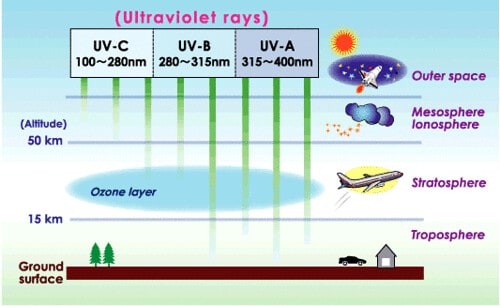We all know that plants require light for photosynthesis and optimum growth, which is why they need more time near or under the sun. BUT, not all light would be useful for plants. Rather, some lights can cause harm and danger to them!
This has you wonder about the two main types of lights, UVA and UVB. Do plants need UVA or UVB? Which one is more preferable and why? Read on to find out!

What is UV Light?
Grow lights need to provide specific wavelengths of light for plants to grow. We can find red, blue, or even a whole rainbow of colors that can help plants perform processes like photosynthesis to grow well. One wavelength of light that many contests is UV light, a wavelength of light invisible to the naked eye, sitting between 10-400 nanometers on our light spectrum.
Before we get into which lights are better for plants, let’s first define the different types of UV lights, which differ from wavelengths:
- Ultraviolet A, or UVA, is from 315-400nm, comprising of around 3% of photons in natural sunlight making through the Earth’s atmosphere. UVA lights don’t damage DNA for plants.
- Ultraviolet B, or UVB, is from 280-315nm, making up less than 0.15% of total natural sunlight. This light is energetic enough to damage DNA, even inducing cancer in humans and animals. Fortunately, our planet’s ozone layer blocks almost all of the UVB light from the sun.
- Ultraviolet C, or UVC, is from 100-280nm and almost entirely filtered out from the Earth’s atmosphere. This isn’t a component of our natural sunlight and is quite dangerous. This light is energetic enough to the point it’s used for sterilization, killing living cells.
Only two major types of ultraviolet light are used in grow room, as others are too powerful to use on this planet!

Do Plants Need UVA or UVB?
With the definition of different UV lights, we now wonder- Which UV light is made best for plants?
Plants respond to UVA and UVB light exposure, with different plants responding in different ways. However, general studies show increased productions of antioxidants, flavonoids, and other natural sunscreen compounds in photomorphogenesis.
For instance, in cannabis plants, exposure to UVA light vs UVB light can increase the production of both CBD and THC.
UVC isn’t naturally present on our planet because of its atmosphere, but UVA and UVB are key parts of our lives. Plants don’t need to always be outdoors to receive and grow from UV light, a there are indoor grow lights to create such light artificially for plants to thrive indoors.
Some grow lights would naturally emit UVA through chemical exchanges, such as HIDs and T5. On the other hand, LED lights may have specialized UVB bulbs or diodes to provide the UV light it lacks.
So the answer here is that the UV light you use depends on the plant variety and its specific light requirements. Both UVA and UVB light are good for plants, offering various benefits. When your plants are exposed to the correct type and amount of UC light, it will produce glycoside, a chemical that helps make way for improved plant growth and taste, along with keeping insects away.
UVB light is known to alter the DNA of fungi that can potentially attack or hurt your plants. When DNA is altered, fungus can’t spread and it protects your plant. UVB light can also improve the color and texture of your plant, boosting its nutrient levels, particularly in fruits.
With that in mind, the amount of UVB needs to be monitored, as too much of it can damage your plants’ DNA. It can further affect your plants’ DNA further, becoming problematic.
As for UVA lights, this is alright to expose to your plants in any quantity, provided that they get the recommended amount. When you provide UVA lights to your plants as it grows, then it can help in your plants growing stronger and more beautiful. UVA lights can also improve the appearance and taste of fruit and vegetable crops.
Why Do Plants Need UV Light?
Plants grow better when under both UVA and UVB lights when in controlled amounts. Here are the benefits UV lights can provide to your plants:
- UVA lights can boost photosynthesis, which leads to improved and quicker plant growth. Studies show that UVA light exposure can increase photosynthesis in plants by 12%, along with boosting plants’ leaf sizes, growth levels, and dry weights.
- UV lights help boost resin production in plants, enhancing the content and quality of both flavonoids and terpenes in crops. These render a richer and vibrant shade, along with better smell and taste to plants. Resin can also prevent plants from losing too much water while protecting them from pests, infections, and other risk factors of plants.
- UV lights can also contribute to plant root development, as the light reaches the plants’ roots, having it grow further. This is very useful when you want to move your plants to relatively intense lights. As long as you expose your plants to correct amounts of UV lights, your plant won’t need other additional supplements even when planting it in foreign locations.
Wrapping It Up
We’ve all been told to stay away from UV light as much as possible, though when exposed in safer doses, UV can give us a great tan without damaging our skin too much. The same goes for plants, which need UV to produce oils that help with their growth and quality taste after harvest. However, you have to make sure that they get more UVA light than UVB, as the latter can cause damage not only to plants but to us humans, too.
I hope that this article answered your question, ‘do plants need UVA or UVB?’ Now that you know the answer, do learn more about the plants’ requirements and nutrients needed for them to thrive. Good luck gardening!